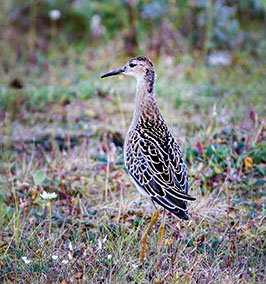Press release 2014-04-23 at 13:35
Finnish Environment Institute (SYKE) and the Finnish Museum of Natural History
Bird populations in Finland have shifted northward by an average of 45 km between the 1970s and the 2010s due, in particular, to climate change. Before this, the effects of climate change have been studied through changes in the distribution of species. A new study method also takes into account regional shifts in population density.
 The ruff. Photo by Petri Ahlroth.
The ruff. Photo by Petri Ahlroth.
A new study by the Finnish Environment Institute (SYKE) and the Finnish Museum of Natural History shows that northern species are retreating northward at greater speed than southern species are spreading to new areas.
Climate change has been predicted to affect the ranges of species as favourable climate conditions shift towards the poles. According to the new study, the mean weighted latitude of density of Finnish bird populations has shifted northward by an average of 45 km, as predicted.
The density of northern species has shifted more (73 km) than that of southern species (27 km). In as many as 23 species, such as black grouse, ruff, greenfinch and yellow wagtail, the mean weighted latitude of density has shifted northward by over a hundred kilometres. A southward shift of over a hundred kilometres was observed in only two species (common buzzard and common raven).
More accurate information through observation of density shifts
Unlike in previous studies, the study behind this new publication looked at the regional density shifts of species during different decades, starting from the 1970s. Density estimates provide significantly more information about species’ response to climate change than only studying their ranges, which has been standard practice in these kinds of studies until now. Such studies have concluded that species’ ranges shift northwards as the climate warms, but looking at density shifts provides more detailed information about changes in the abundance of species.
Changes in the mean weighted latitude of density were compared to distribution changes observed and recorded in bird atlases from 1974 to 2010. The comparison revealed that the range of southern species shifted more to the north on average than the mean centre of the weighted density of the species, while in northern species, density shifted more to the north than the range.
“This study shows that the populations of northern species are retreating northward at a faster rate than what studies looking at changes in range have shown in the past,” says Leading Researcher Raimo Virkkala from the Finnish Environment Institute (SYKE). “These species are increasingly at great risk of disappearing from the Nordic countries, as the Arctic Ocean limits their shift to the north.”
A million bird observations confirm the results
The study is based on the long-term monitoring of bird populations using the same line transect method. The observational data of the study consisted of nearly a million (990,301) observations of 94 different bird species, and the results have now been published as part of the international Global Change Biology publication series.
“Census data gathered by volunteer bird watchers is invaluable for the comprehensively study of long-term changes in bird populations. Each bird monitoring count is an important part of the national and international bird monitoring network,” thanks Curator Aleksi Lehikoinen, the coordinator of the Finnish Museum of Natural History’s bird census efforts.
More information
Curator Aleksi Lehikoinen, Finnish Museum of Natural History, tel. +358 (0)50 318 2340, firstname.lastname@helsinki.fi
Leading Researcher Raimo Virkkala, Finnish Environment Institute (SYKE), tel. +358 (0)400 148 668, firstname.lastname@ymparisto.fi
Links